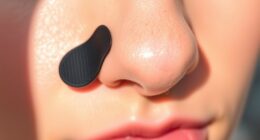Understanding acid use (AHA, BHA, PHA) helps you select the right exfoliants for your skin. AHAs like glycolic and lactic acids work on the surface to brighten dull skin, while BHAs such as salicylic acid penetrate deep into pores to clear oil and acne. PHAs are gentle options suitable for sensitive skin, offering similar benefits. Knowing how each acid works and how to apply them safely guarantees healthier skin—if you continue, you’ll discover even more tips for effective usage.
Key Takeaways
- AHAs, BHAs, and PHAs are exfoliating acids with different skin penetration depths and benefits.
- Proper pH levels are essential for acid efficacy and skin safety during use.
- Always perform patch tests and start with low concentrations to minimize irritation.
- Use sunscreens diligently to protect skin when using acids, especially during daytime.
- Combine acids carefully with other ingredients, avoiding layering with retinoids or harsh actives.
What Are AHAs, BHAs, and PHAs?

Have you ever wondered what sets different acids apart in skincare? AHAs, BHAs, and PHAs are all types of acids used for chemical exfoliation, each targeting skin renewal in unique ways. AHAs, like glycolic and lactic acid, work on the skin’s surface, helping remove dead skin cells and brighten your complexion. BHAs, such as salicylic acid, penetrate deeper into pores, making them effective for oily and acne-prone skin. PHAs, including gluconolactone, are gentler exfoliants suitable for sensitive skin, offering similar benefits without irritation. Understanding these acids helps you choose the right one for your skincare needs, promoting healthier, more radiant skin through effective chemical exfoliation. Each type plays a pivotal role in renewing your skin’s outer layer, and embracing a consistent creative practice can enhance your overall approach to skincare and self-care routines.
How Do These Acids Work on the Skin?

When you apply acids to your skin, they help speed up the shedding of dead cells, revealing fresher skin underneath. They also adjust your skin’s pH level, making it less prone to breakouts and irritation. Understanding how these processes work can help you use acids more effectively in your skincare routine.
Skin Cell Turnover Boost
Curious about how acids enhance your skin’s renewal process? When you use acids like AHAs, BHA, or PHA, they promote skin renewal by gently exfoliating the surface layer. This process mimics a chemical peel, removing dead skin cells and revealing fresher, healthier skin underneath. By boosting cell turnover, these acids help reduce dullness, fine lines, and discoloration. They also prevent clogged pores, making your skin look clearer and more vibrant. Regular use encourages the growth of new, resilient skin cells, improving texture and tone over time. Think of acids as your skin’s natural renewal partner, helping you achieve a smoother, more youthful complexion through consistent exfoliation and renewal. Using products with the right mattress toppers can also improve sleep quality, contributing to healthier skin overall. Incorporating dynamic communication exercises into skincare routines can also enhance your understanding of your skin’s needs, leading to better product choices and results. Additionally, understanding the trustworthiness of AI models can help you make more informed decisions about skincare technology and innovations. Understanding the resources and tools available for skincare can further support your journey to healthier skin.
Ph Level Adjustment
Understanding the pH level of acids is essential because it determines how effectively they work on your skin. When acids are properly pH balanced, they can penetrate your skin’s surface without causing irritation, leading to better exfoliation and cell renewal. pH balancing ensures the acid’s strength matches your skin’s natural acidity, optimizing their benefits. Acid neutralization is also key; it prevents acids from becoming too harsh by stopping their activity at the right moment. If the pH is too high, the acids won’t work effectively, reducing their exfoliating power. Conversely, if it’s too low, you risk irritation or damage. Knowing how to adjust the pH of these acids helps you use them safely and effectively, enhancing your skincare routine. Proper acid formulation is crucial for achieving the desired results without adverse effects.
Benefits of Using Exfoliating Acids
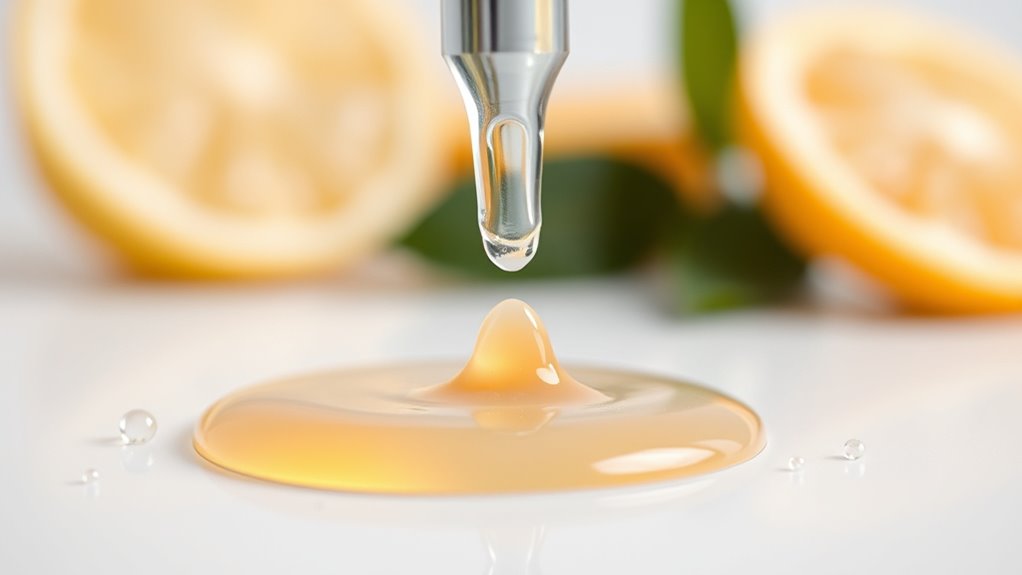
Exfoliating acids offer numerous benefits for your skin by promoting a brighter, more even complexion. They enhance chemical exfoliation, helping remove dead skin cells and accelerate skin renewal. This process reveals fresher, smoother skin beneath, reducing dullness and uneven tone. Incorporating enzymes in skincare can further support the natural exfoliation process and improve overall skin health. Regular use can minimize the appearance of fine lines, acne scars, and enlarged pores. To visualize these benefits: chemical exfoliation can be a key step in your skincare routine, leading to healthier-looking skin. Incorporating glycolic acid products into your regimen can further enhance skin texture and radiance.
Choosing the Right Acid for Your Skin Type
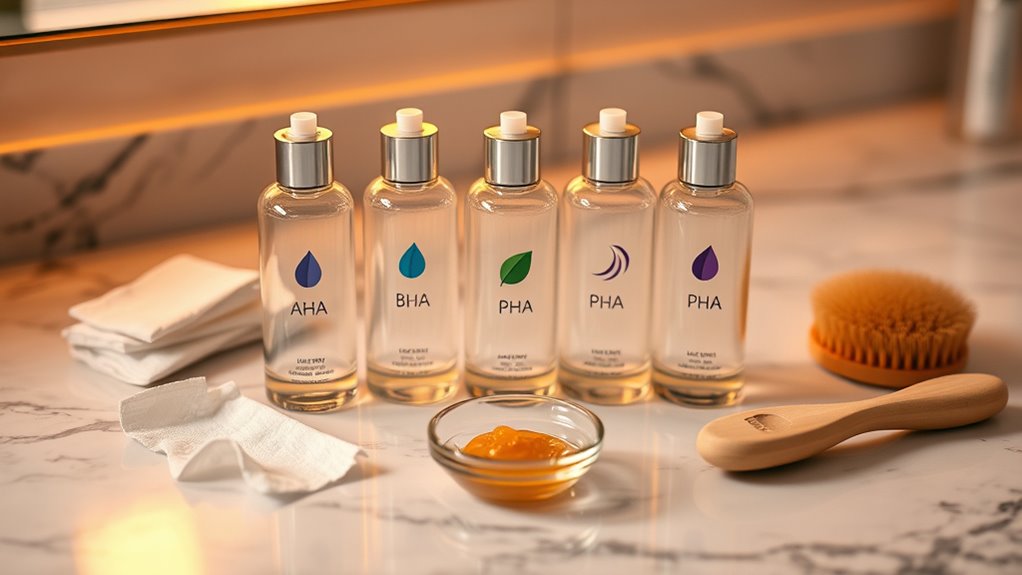
Choosing the right acid for your skin type guarantees you get the best results while minimizing irritation. If you have sensitive skin, look for acids specifically formulated for delicate skin, such as PHA, which are gentler and help with hydration. For oily or acne-prone skin, BHA like salicylic acid works best to unclog pores and reduce breakouts. Dry skin types benefit from AHAs like glycolic acid, which promote exfoliation and brighter skin. Pair acids with moisturizers to reduce dryness and irritation, especially if you’re new to acids. Always start with lower concentrations, and observe how your skin reacts. Understanding the benefits of eye patches can help you incorporate targeted treatments into your skincare routine for enhanced results. Additionally, understanding the different types of acids can guide you in selecting the most suitable option for your skin’s unique needs. Remember, selecting the appropriate acid and understanding your skin’s needs ensures effective exfoliation without unnecessary discomfort.
Proper Application and Usage Tips
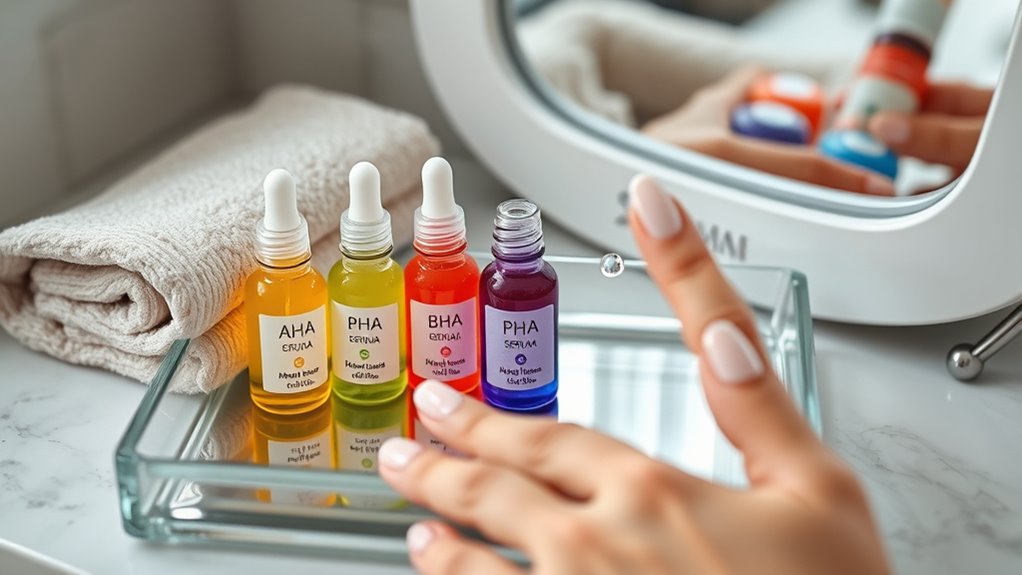
To get the best results and minimize irritation, it’s important to apply acids correctly and consistently. Start by ensuring your skin is clean and dry before applying. Use a pH-balanced toner if needed to prepare your skin and promote proper pH balancing, which helps acids work effectively. Apply acids in thin, even layers, avoiding overuse. Remember to layer ingredients thoughtfully: apply lighter, water-based acids first, then follow with thicker products if necessary. Always follow the manufacturer’s instructions regarding frequency—most acids are best used a few times a week initially. Be sure to wait a few minutes between steps to allow each product to absorb. Proper application and ingredient layering optimize benefits while reducing the risk of irritation or imbalance. Additionally, choosing vetted products ensures safety and effectiveness.
Potential Side Effects and How to Avoid Them
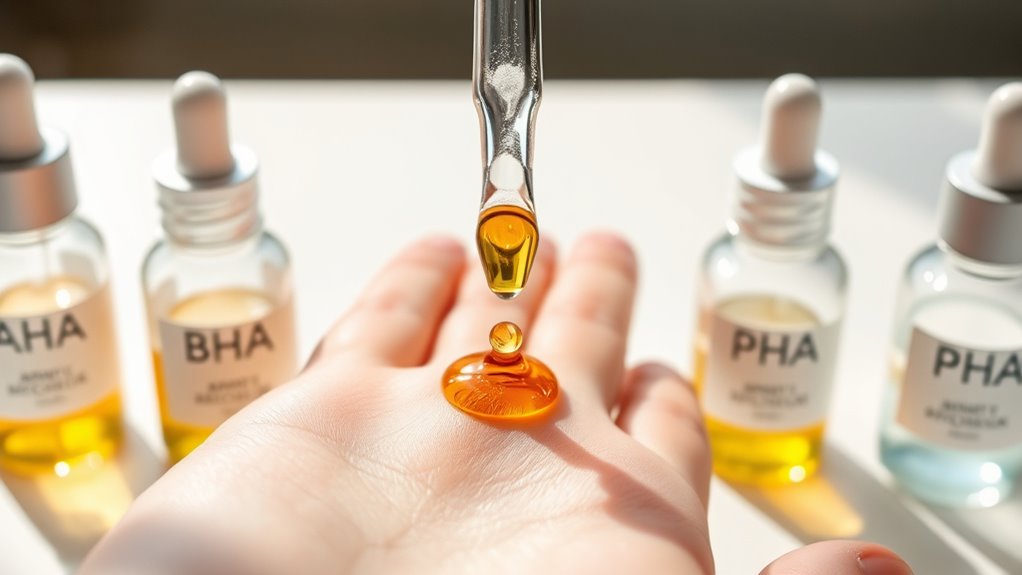
You might experience skin sensitivities if you don’t recognize how your skin reacts to acids. Always apply proper sun protection to prevent irritation or damage. Following application guidelines helps minimize side effects and keeps your skin safe. Additionally, understanding your skin type can help you choose the right acid products and avoid adverse reactions skin sensitivities. Being aware of patch testing procedures and how different modifications can affect your vehicle’s performance can also inform safer application practices.
Recognize Skin Sensitivities
Skin sensitivities to acids can cause redness, irritation, or discomfort, especially if your skin is prone to reactions. If you have sensitive skin, it’s essential to approach acid use carefully and monitor how your skin responds. Conduct a patch test before applying acids to your face to detect potential allergies or sensitivities. Be aware of allergy awareness signs, such as persistent redness or burning, and stop use immediately if you experience these symptoms. Using acids too frequently or in high concentrations can increase irritation risks. Incorporating soothing ingredients and limit initial applications to every few days. Recognizing your skin’s unique sensitivities helps you avoid adverse reactions and ensures a safer, more effective skincare routine. Developing a methodical testing process can further help you identify the appropriate frequency and concentration of acids suitable for your skin. Understanding skin barrier function also plays a vital role in preventing irritation and maintaining healthy skin.
Use Proper Sun Protection
While using acids can improve your skin, improper sun protection can lead to side effects like increased sensitivity, sunburn, and uneven pigmentation. To guarantee acid safety, it’s essential to protect your skin from UV damage. Always apply a broad-spectrum sunscreen with at least SPF 30, even on cloudy days. Reapply every two hours and after swimming or sweating. Wear protective clothing, such as hats and sunglasses, to minimize sun exposure. Avoid peak sun hours between 10 a.m. and 4 p.m. Stay in the shade whenever possible. Remember, proper sun protection helps prevent adverse effects and keeps your skin healthy while using acids. Incorporating sunscreen application techniques can also enhance your protection routine. Prioritize sun safety to maximize benefits and reduce risks associated with acid use. Being aware of narcissistic behaviors can also help you recognize and avoid emotional harm from others during your skincare routine. Additionally, establishing a consistent sun protection routine can further safeguard your skin and optimize your skincare results.
Follow Application Guidelines
Applying acids correctly is key to achieving the best results and minimizing side effects. Always follow application guidelines to guarantee proper pH balancing and avoid irritation. Check the product’s recommended acid concentration; using a formula with too high a concentration can cause burns or redness, while too low may be ineffective. Before applying, do a patch test to see how your skin reacts. Follow instructions on how long to leave the acid on your skin, and avoid overuse, which can disrupt your skin’s natural pH balance. Remember, less is often more—start with lower concentrations and gradually increase as your skin builds tolerance. Proper application helps maintain pH balance and prevents potential side effects, keeping your skin healthy and protected.
Combining Acids With Other Skincare Ingredients

Combining acids with other skincare ingredients can enhance your routine’s effectiveness, but it’s essential to understand how they interact. Ingredient interactions and compatibility considerations matter to avoid irritation or reduced efficacy. Some ingredients may boost your results, while others could cause adverse reactions. Always check if products are compatible before layering.
- Use antioxidants like vitamin C in the morning, avoiding acids to prevent irritation
- Avoid combining acids with retinoids to reduce sensitivity
- Incorporate hydrating ingredients like hyaluronic acid to balance exfoliation
- Steer clear of benzoyl peroxide directly after acids, as it can deactivate them
- Test new combinations on a small skin area first to observe reactions
Understanding these interactions helps you create a safe, effective skincare routine.
Incorporating Acids Into Your Skincare Routine Safely

Incorporating acids into your skincare routine can be highly effective when done safely and thoughtfully. To maintain your skin’s health, pay attention to your skin’s pH balance, ensuring acids are used at appropriate strengths. Start by introducing acids gradually, monitoring how your skin reacts. Use acids in conjunction with gentle cleansers and moisturizers to promote ingredient synergy, which enhances effectiveness while reducing irritation. Avoid layering acids with other active ingredients that may disrupt your skin’s pH or cause sensitivity. Always follow product instructions and consider patch testing new acids. Incorporating acids correctly helps exfoliate dead skin cells, improve texture, and brighten your complexion without compromising your skin’s barrier. Remember, patience and moderation are key to safely reaping acid’s benefits.
Frequently Asked Questions
Can Acids Cause Long-Term Skin Damage?
You might worry about long-term damage from acids, but when used correctly, they generally don’t cause lasting skin concerns. Overuse or high concentrations can lead to irritation, sensitivity, or even damage, so it’s important to follow product instructions. If you notice redness or peeling, cut back. Proper use helps improve skin texture and promotes healthier skin without risking long-term damage. Always patch-test new products to stay safe.
Are Acids Safe for Sensitive or Reactive Skin?
Your skin sensitivity might feel like it’s on the brink of disaster, but acids can be safe if you choose the right ones. When you pick acids suited for your skin type, they can improve your skin without causing irritation. Always check ingredient compatibility and start with lower concentrations. With careful use, acids won’t turn your sensitive skin into a battlefield—they can actually help soothe and improve your skin’s health.
How Often Should I Incorporate Acids Into My Routine?
You should start by evaluating your skin tolerance to acids, then adjust the frequency of use accordingly. For sensitive skin, begin with 1-2 times a week and gradually increase if your skin reacts well. For normal or resilient skin, 3-4 times weekly often works. Always listen to your skin’s response, and avoid overdoing it to prevent irritation. Consistency and observing your skin’s cues are key to safe, effective acid use.
Can Acids Be Used Alongside Prescription Medications?
Coincidentally, you might wonder if acids can be safely combined with prescription medications. Generally, combining acids with retinoids can cause irritation, so it’s best to consult your dermatologist. During pregnancy, acid use should be cautious and avoided unless approved by your doctor, as some acids aren’t safe. Always check with your healthcare provider before mixing acids with any prescription meds to guarantee your skin’s safety.
What Ingredients Should I Avoid When Using Acids?
When using acids, you should avoid ingredients that can disrupt your skin’s pH balance or cause irritation, like retinoids, vitamin C, and benzoyl peroxide. These ingredients may interact with acids, leading to redness or sensitivity. Always patch-test new products and consult your dermatologist if you’re unsure about ingredient interactions. Staying mindful of these combinations helps protect your skin and keeps your routine effective.
Conclusion
Incorporating AHAs, BHAs, and PHAs into your skincare routine can transform your skin, with studies showing that 70% of users notice smoother, brighter skin within just four weeks. By understanding how these acids work and choosing the right one for your skin type, you can enjoy clearer, healthier skin without irritation. Just remember to start slow, follow proper application tips, and listen to your skin’s signals for the best results.






